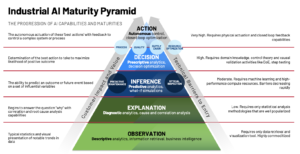The Activation Imperative
Bridging Vision and Value in Digital Transformation
Executives struggling to capture value from digital initiatives must shift focus – away from chasing technology trends and toward building a business-first, people-centered and data-driven foundation for change.
Industrial companies today face a major opportunity and a growing dilemma. Artificial intelligence (AI) and continuously evolving technologies offer unprecedented potential to transform operations, but many organizations still struggle to realize value, as we discussed in Digital Transformation: A Revolution Just Beginning, Not a Trend Fading Away. Despite significant investments, they’re stuck in strategy mode, overwhelmed by pilot projects and facing growing skepticism about digital transformation’s impact.
“[Digital transformation] can only be answered by harmonizing capability and business strategy. Yet very few companies can draw a straight line between their business strategy and their capability investments (both technology and human capital), leading many to be influenced by trends.” -Forbes
In the fiercely competitive landscape of today's markets, where product quality, availability, innovation, and supply chain reliability are crucial, how do companies rise above the rest? The answer lies in leveraging technology and embracing digital transformation to operate with greater autonomy, intelligence, and security. A forward-thinking vision, robust strategy, and precise execution plan are indispensable. Only those who master these elements will thrive, overcoming workforce challenges and driving success.
As Henry Ford said, “Vision without execution is just hallucination.” To achieve a vision like autonomous operations, organizations need to plan and execute each step with an emphasis on preparation, focus and strategic intent.
Solving Common Digital Transformation Challenges
In our previous article, we laid out the top three roadblocks that organizations are putting in their own way towards a successful digital transformation journey leading to stalled digital initiatives and disappointing returns. Here’s where our Digital Value Accelerator (DVA) comes in. DVA is a proven approach to help companies accelerate their digital ambition from vision to value by assessing current capabilities, aligning on priorities and mobilizing teams for scalable execution.

It isn’t just a framework—it’s a blueprint for modern industrial reinvention. It’s how companies break out of pilot purgatory and deliver repeatable, scalable and measurable outcomes.
While many competitors offer digital transformation planning, most stop at the strategy. We take you to the finish line.
Our approach includes a critical mobilization phase that aligns and champions leadership, establishes governance and launches an actionable execution plan.
We don’t just assess tech. We connect business drivers, use cases and technical architecture to build a digital transformation roadmap that’s both strategic and actionable. Our deep understanding of industrial operations lets us engage at the front lines, ensuring every plan is grounded in real-world conditions while working toward the vision of more autonomous operations.
Here’s what we know:
- Strategy always starts with outcomes, not tools.
- Transformation without people is a failed experiment.
- Results don’t scale unless strategy connects the plant floor to the top floor.
- Build for what’s next, not just for what’s now.

So where does this fit in in helping you see success and what are the key digital transformation challenges that often stand in the way?
Problem #1: Tech-First vs. Business-First
Many companies invest in automation without a clear link to business impact. According to the Manufacturing Leadership Council’s Future of Manufacturing Survey, only 35% of respondents have an enterprise-wide AI strategy.
Leading with this approach, these technology-led investments often miss the mark, failing to address core business pain points or seize key opportunities. The result? Wasted resources and stalled digital initiatives.
How We Approach It
We begin with a business-driven evaluation. This is a deep assessment of operations, financial performance, and strategic goals. We focus on proactive advancements versus reactive fixes to position for long-term success. Establishing a clear mandate as the north star helps align leadership and mitigate potential barriers at both executive and site levels.
Instead of chasing isolated technology pilots, we build a digital transformation roadmap that prioritizes use cases based on business impact, complexity and scalability. This roadmap aligns leadership, secures funding and ensures that digital transformation delivers tangible value from the start—often in months, not years. Regular value drops continue to demonstrate technological capability while prioritizing the measurement and capture of ROI and self-funding later initiatives.
For example, by aligning digital initiatives with core business drivers, like reducing Cleaning in Place (CIP) cycle times and improving yield forecasting, a CPG organization is well positioned to move from pilot purgatory to achieve results like an increase in OEE, a reduction in energy consumption and a scalable AI model now embedded in daily operations.
By securing buy-in at both the executive and site leadership levels, we also ensure that every proof of value is highly visible and designed to replicate once proven.
Problem #2: Ignoring the Human Factor in Digital Transformation
Digital transformation fails when organizations overlook the obvious, its people. Technology alone won’t drive change. Resistance, misalignment and disengagement can derail even the best initiatives. Cultural or organizational-wide buy-in and leadership alignment are key to making any solution successful.
How We Approach It
We prioritize implementation over excessive strategizing by focusing on customer data to create human-centered, tailored solutions. From the start, we engage stakeholders at all levels, ensuring alignment and buy-in through comprehensive interviews and leadership alignment during planning and mobilization.
Effective change management isn’t just about sending out email communications and conducting standalone training sessions. The DVA incorporates a comprehensive and structured OCM strategy to tackle the emotional and practical aspects of change.
Problem #3: Underestimating the Importance of Having a Good Data & IT/OT Architecture Strategy
Companies generate massive amounts of operational data but often struggle to turn it into business value. Many pilots fail to scale due to inadequate IT/OT architecture – and choosing the wrong technology only compounds this issue. The problem is not all data is good data. Even with solid data structures, governance and teams, much of the data may still not be aligned to specific transformation goals, ultimately impeding digital value realization.
How We Approach It
The DVA identifies gaps in your current data infrastructure, like disconnected IT and OT systems that prevent critical insights, such as predictive maintenance or energy optimization, through an IT/OT data architecture assessment. Disconnected enterprise systems and plant-floor technologies (OT) are a drag on transformation. Organizations need to bridge these silos and align technical data with business objectives. Standardizing architecture and governance reduce risk and unlocks value. Industrial knowledge graphs and data ops toolkits, which connect data contextually, make it easier to drive intelligent, scalable decisions. This isn’t just modernization; it’s transformation with purpose.
From Transformation to AI-Native: What’s Next?
Let’s be blunt: Digital transformation as we know, or knew it, is over. Or rather, it’s not enough anymore. The pilot programs, isolated technology adoption and endless strategy decks of five years ago won’t cut it in an AI-native world.
Today, it’s not about plugging AI into outdated models. It’s about rethinking the model itself. AI is the default, not the add-on. This is more than a tech upgrade. It’s a fundamental shift in how businesses function, how value is created and how people contribute.
We’re entering an era, the Autonomous Age, where roles won’t just evolve, they’ll be redefined. Think less “supply chain analyst” and more “supply chain AI agent managers.” The job won't be to do the task. It’ll be to guide, govern and optimize the AI that does it. This shift demands new skills, new mindsets, and a new relationship between humans and machines.
The future is about smart, incremental moves that deliver real value—powered by open, interoperable systems that break down silos and accelerate innovation. Closed architectures and disconnected tools are relics of the past. In an AI-native world, seamless integration isn’t a nice-to-have. It’s survival.
The convergence of human creativity and machine intelligence in Industry 5.0 is already upon us. Technologies like robotics, IoT, AI and other immersive technologies are collaborating in real time to shape smarter operations.
But there’s a catch. None of this works without a relentless focus on execution. Intelligence needs to be embedded in every process, decision and layer of the organization.
Where others see transformation as a project, we see it as an operating model shift.
Where others stall at strategy, we build momentum through value-first delivery.
Where others chase hype, we connect the dots between business intent, human capability, and intelligent systems.
Are You Ready?
Your competitors are planning. Talking. Piloting. You? You’re ready to move.
The age of industrial AI demands more than vision. Kalypso’s DVA is your advantage in the field. Let’s not just imagine the autonomous enterprise. Let’s build it.
In the future, there will be two kinds of companies: those who execute a clear vision with AI, and those who don’t exist. You decide which your organization will be.

